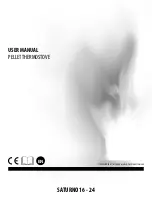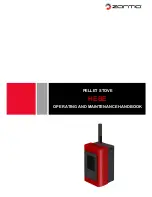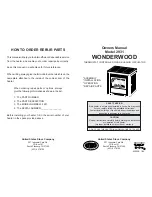
© 2007-2008 Broseley Fires Ltd
3.
HEATABLE
AREA
(VOLUME)
The
heating
volume
of
the
appliance;
according
to
DIN
18893;
will
vary
depending
on
the
amount
of
thermal
insulation
that
the
property
has.
Properties
with
high
ceilings,
draughty
windows
and
doors,
solid
brick
walls
and
poor
insulation,
these
are
all
going
to
affect
the
potential
maximum
heating
volume
of
the
appliance.
Property
with:
favourable
construction
‐
186
m
3
less
favourable
construction
‐
107
m
3
unfavourable
construction:
‐
73
m
3
Using
the
correct
fuel
in
the
appliance,
having
suitable
thermal
insulation
of
the
property
and
complying
with
the
instructions,
the
heating
volume
is
the
greatest.
3A.
KEY
ENVIRONMENTAL
CONSIDERATIONS
To
minimize
the
impact
on
the
environment
the
following
issues
need
to
be
considered
when
proposing
to
install
a
solid
fuel
appliance:
•
Local
authorities
(Councils)
must
be
consulted
for
any
restrictions
that
may
apply
to
the
use
of
solid
fuel
appliances
in
certain
areas
such
as
smoke
free
zones.
•
The
appliance
must
be
correctly
sized
to
suit
the
space
and
necessary
clearances
must
be
strictly
adhered
to.
•
The
appliance
and
flue
system
must
be
correctly
installed
to
the
current
regulations
in
force
at
the
time.
•
The
appliance
must
be
correctly
operated.
•
The
appliance
and
flue
system
must
be
properly
maintained.
•
It
is
also
important
to
ensure
that
the
dwelling
to
be
heated
is
insulated
and
is
as
energy
efficient
as
is
practical.
•
The
correct
fuel
must
be
used.
The
selection,
installation,
correct
use
and
maintenance
of
wood
burning
appliances
and
flue
systems
are
discussed
in
more
detail
in
the
following
sections
of
these
instructions.
4.0
THE
‘AIR’
CONTROLS
The
stove
is
fitted
with
controls
that
adjust
the
flow
of
air
into
the
unit.
It
is
very
important
that
these
controls
are
fully
understood
in
order
to
achieve
the
best
results
from
your
stove.
When
operating
the
controls,
ensure
that
they
are
used
in
small
increments
and
not
changed
by
large
amounts
suddenly.
Do
not
use
them
like
an
on
–
off
switch.
It
is
important
that
the
following
controls
are
used
correctly.
The
air
controls
are
as
follows:
•
PRIMARY
AIR
CONTROL
•
SECONDARY
AIR
CONTROL
(AIR
WASH)
•
THERMOSTAT
CONTROL
•
FLUE
PATH
SHUTTER
CONTROL


































